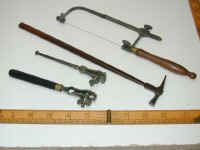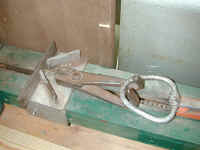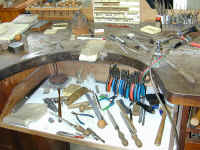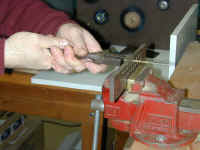Using the mouth-blown torch.
Cupids representing Goldsmiths at work. Pompeii
My work bench with the Ash bench peg.

The studio
Ingot mould and crucible in holder.
Wire and plate rolling mills
Ring clamps, and shellac stick.
Clamps for holding.
Ring mandrel and emery sticks.
Lay out tools.

Saw frame, hammer and pin vices.
Pliers.
Disk cutter.
Setting punches and blocks.
Swaging block, Doming punches and block.
Heart shape punches and lead block.

Drawing wire through Draw Plates. Changing and/or reducing cross-section.

Draw bench.
Ring bender.
Ring stretcher / shrinker.
Engraving and diamond setting tools.

Engraver's ball vices.
Polishing motor with dust extraction.
Peter McBride Goldsmith / Jeweller.
The techniques and tools used in jewellery making have a very long history. Evidence from Pompeii shows the basic jewellery making tools I use were in use 2000 years ago - hammer, anvil, scales, mouth blown torch for example. I walked into the room in the House of Vetti, Pompeii and felt like I'd been hit by lightning when I saw the fantastic paintings of cupids representing the activities of the city. Click on the thumbnail link to see a large scan of the painting on that wall.
The metals commonly used in jewellery making are Gold, Silver, and Platinum. Platinum is more expensive than gold– it is about twice the price by weight, and slightly more dense. It is not mixed or alloyed with as much other metal as gold. The standard alloy for platinum that I use is 95% platinum 5% copper. It is also harder to work, and many people prefer the colour of gold. The gold used in jewellery making is normally a carefully selected alloy. Pure gold is “24 carat”. “18 carat” gold contains 75% pure gold by weight, and the mixture I use for making his 18ct yellow gold is 75% gold, 13% silver and 12% copper.
Increasing the proportion of copper to say 20% will give a “red gold” and make it slightly harder, increasing the proportion of silver to 20% will give a “greenish gold colour” and make it significantly softer. The addition of white metals such as Palladium, Nickel and Silver will make “white gold”
I make my own yellow gold alloys, stamp the metals for purity and put my own Maker’s Hallmark on the work. The stamps can be straight or cranked with a dogleg to allow the stamp to get to the inside surface of a ring.
All metal shavings are collected and returned to a refiner. All the metal waste or “lemel” is mixed together, but the refiner separates the pure metals again and returns them for alloying and re-use.
Basic Techniques.
There are 4 major techniques for making jewellery. These different methods demand varying levels of skill, and often they will be combined to achieve a given or desired design. The standard or quality of the article produced will also vary with the selection of a manufacturing technique. The techniques are listed below, together with some examples of items produced using each process. However, the design of a fully handmade ring, for example, may also be executed using an assembly of items made using three different production techniques. A cast shank or band may have a handmade setting and die struck shoulders, for example.
1. Hand made construction.
Almost Anything.
2. Lost wax casting process.
Pendants / Rings / Chain / Bangles / Bracelets / Earrings.
Lower priced budget jewellery.
Ring shanks - bands with or without the head or setting already in situ.
Chain links.
Whole or sections of necklaces or pendants.
3. Machining and diamond cutter tooling.
Wedding ring blanks.
Gentleman's signet style rings.
Chains - especially large volumes of Italian and German machine made solid and hollow link chains.
Findings and Fittings - chain clasps, carring wires and clips, cuff-link backs, brooch hinge and roller catches.
4. Die struck
Settings for gemstones.
Shoulders for assembled rings.
Findings and Fittings.
Casting is often used for lower grade work and as cast metal is likely to be porous, brittle and soft it does not produce durable products. In small items such as the components of jewellery, no metal defects can be tolerated. By contrast, like all forged metals, wrought gold has a fine grain crystal structure and is sound, tough, and hard.
Working gold is like working copper – as it deforms it hardens and it must be annealed regularly as the work progresses to keep the metal in a workable condition. Annealing is usually carried out with bushy flamed torch and the temperature of the piece being judged by its colour.
The ingot of alloyed gold is made by melting the mixture of metals in a crucible with flux. Pouring it molten into an ingot mould and allowing it to solidify.
The gold is then cold rolled through flat or wire rolling mills to reduce its cross section and improve the crystal structure after subsequent annealing. The rolled square wire can then be further rolled to form flat, half round or other wire cross sections as required. The wire can also be drawn, either by hand or by machine through draw plates to form round and many other shaped wires. This selection of material is then cut to length, twisted, bent, hammered, filled punched etc. to form the components of the item at hand.
Tube is often used and is called chenier (chenier – French, to hinge and schanier – German, to hinge) because an early common use of tubes in gold smithing and in particular silversmithing was for the making hinges for vessels. To make a tube plate is cut to the necessary width and swaged in a swage block and then drawn with draw-tongs through progressively smaller holes in a draw plate. The edges can be soldered and a short length cut off and pressed into a tapered hole in a setting block and struck with a tapered punch to accurately form it’s taper and form. This tapered tube can then be cut, drilled, and filed to form claws on the collet for setting a gem.
Decorative effects may be produced by repousse work or by chasing.
Repousse work is done by attaching a sheet of metal to pitch in a pitch bowl and shaping the metal into the required shape, from the back buy hammering punches with a repousse hammer into it. Chasing is the process of applying a design to the face of the work piece by punching into the face with a suitably shaped tool hitting it with the repousse hammer.
The Bench Peg.
This is a ramp shape wooden work block, mounted securely to the middle of a semicircular cut-out in the bench top. The work held in clamps, pliers, wax or shellac sticks, and particularly in the fingers, is pushed up hard against this peg with the left hand whilst working on it with tools in the right hand. I make my own peg from English Ash, hard and strong.
Pliers.
I use a variety of pliers, and prefers those with box joints. Common pliers have a halved hinge – identical arms are pinned at the hinge. Pliers with a box joint are so made that one arm goes through the other to make a tighter and more durable joint and so provide more reliable movement at the jaws and so gives even clamping pressure across the face of the jaws. Important to keep the work from being marred. Or moving whilst being worked on.
To avoid the risk of developing the carpel tunnel syndrome, the hand should be kept in line with the forearm. This is particularly important when one hand is being used to hold the work piece while it is being worked on for a long time, a common situation in jewellery making. I have adapted many of my pliers so that I can use them to hold the work without having my hand at an angle to my forearm.
Ring clamps and pin vices.
Ring clamps are usually a very basic tool, essentially a dowel, cut along its length, and with a collar to stop it spreading, a wedge is driven into one end and the work held in the other. Some are made from brass or aluminium, with a variety of screw type closing systems, to hold the ring in different orientations, as needed for working different directions, and surfaces. Pin vices are used to hold wire or chenier firmly whilst cutting to length or shaping by cutting drilling and filing etc.
Ring and setting Mandrels.
A tapered steel mandrel with a knurled handle, marked with ring sizes in the standard British system of A – Z. Used to form metal into a circular shape, and to “round up “a ring. The metal is formed with the fingers, a soft hammer made of rawhide, plastic, or the variety of steel hammers. Often a hole is drilled into the face of the bench top to support the small end of the mandrel. Setting mandrels are also tapered, but allow a ring of metal to be shaped to suite a gemstones shape. They may be square, rectangular, octagonal, oval, or most any geometric shape.
Jeweller’s saw frame.
The saw is used with very fine blades to cut metal to length, and to pierce out patterns after a hole has been drilled. The blades are in a range of thicknesses. A few teeth must be in the metal at any time, so when very thin metal is being cut, a very fine blade must be used.
Files.
Two types of file are used, larger bench files and smaller needle files. Both are cross cut to avoid the risk of the file grabbing the work and spinning it in the fingers. This can cause a very deep painful cut to the tips of the fingers. The files are in a variety of shapes to suite the work, eg. Flat half round, three square (triangular) knife-edge. Often one face of a file is ground smooth to create a “safety edge” to allow filling critical shapes and dimensions without unwanted cutting in another direction.
Emery sticks. Wooden sticks with various grades of wet & dry emery paper wound around. Flat, triangular, half round, and round. Used to emery out the file marks before polishing using felt wheels, brushes and buffs and polishing compounds of reducing grit size.
Ring bender.
A ring bender is a hand operated mechanical swaging machine, used to form up a length of metal into a flat ring shape. It keeps the metal flat and avoids the tendency of the metal to dish inwards as it is bent into a circle.
Doming punches and blocks.
A common form in jewellery is the sphere, dome, or sections of them. To form them a set of graduated punches, and a block with graduated semi-spherical holes is used. These punches can also be used to push metal into shape in a cake of lead, or in a wooden end-grain block.
Hammers.
I use many different sizes and types of hammers. Heavy mash hammers for striking punches, soft copper, plastic and rawhide hammers to avoid marring the metal. Repousse hammers, fine riveting hammers, cross-peening, and ball-peening hammers for forging.
Engraving, and diamond setting tools.
Short steel chisel like tools fitted to wooden mushroom shaped handles, Used to cut lines for engraving, or to cut up claws for gem setting. Some are shaped for pushing, and burnishing metal down hard onto a gemstone.
Soldering and annealing torches.
There a number of different types and sizes of torch used, A large Oxy – LPG torch for melting and annealing, a Micro Oxy – LPG torch for fast fine work, to get in and then out with the heat before another joint is weakened or broken. And my favourite, the bench mounted mouth-blown natural gas torch. This effectively gives an extra hand to work with, and a control of the flame not achievable any other way.
Disc punch. A series of graduated punches in a die block, used to cut round discs, by striking with a hammer.
Chenier cutter.
A simple jig used to cut multiple lengths of Chenier or wire the same size. For example chain links, settings for cluster rings, or hinge knuckles.
Engraver’s Ball.
A solidly made ball which can carry a ring clamp or other holding device. The ball, about 120 mm in diameter, sits in a matching socket, so that the work piece being held can be freely located in any desired position.
Diamond setting tools.
Tools very similar to engraving tools that are used to cut, lift and shape claws to hold gemstones, and pushing tools used to work the claws, or bezel (box type form) over the gemstone.
Polishing.
Brushes and buffs are used on a tapered spindle, with various grades of grease based polishing compounds, tripoli, dialux (white, green etc.) and rouge. The dust is vacuum extracted.





